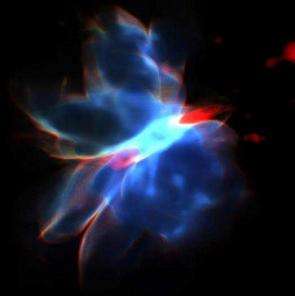The Hitchhiker's Guide to Galaxy Formation

One hundred million years after the Big Bang, giant primordial stars heated, ionized, and pushed the gas around them to form present-day stars and galaxies. And now, for the first time, we can see it happening—in a 3-D simulation.
"The stunning thing about the simulation is its resemblance to star-forming regions in our own galaxy, as seen from the Hubble telescope," says SLAC's Tom Abel, whose team at the Kavli Institute of Particle Astrophysics and Cosmology (KIPAC) developed the mathematical model for the simulation.
The dazzling images from the simulation take us back to a time when the first stars—massive twinklers millions of times brighter than the sun—lit up the universe. Scientists have long believed that these primordial "Population III" stars gave birth to galaxies, but until now they have lacked the tools to understand how it might have happened. Since these celestial events occurred far back in time, very little evidence is observable with telescopes.
Computer simulation is a promising substitute, but modeling the dynamic environment of a Population III star is a complex problem. The star would not only have heated and pushed the gas around it, but its radiation would have ionized the gas molecules, knocking off electrons and turning the molecules into charged ions. To model the complex interplay of these phenomena, the simulation has to solve a six-dimensional differential equation at hundreds of millions of points for each instant in time.
"Naïve methods will fail," Abel said.
Previous simulation methods made several simplifying assumptions—for instance, they assumed constant gas density around the star, or restricted themselves to a one-dimensional problem. While such simplifications made the problem tractable, they provided only limited insight into the underlying cosmic phenomena.
Abel's elegant alternative is to use a computer graphics technique, called adaptive raycasting, to model the outward spread of ionization from a star. Previous methods were computationally overwhelmed by trying to calculate everything on a uniform grid in space. Raycasting, in contrast, allows the computations to be tied to gas density—denser regions are analyzed with a finer grid, optimizing the calculations at any point in space. By combining adaptive raycasting with gas dynamics, Abel's algorithm captures the dynamic complexity of the cosmic churning that precedes star and galaxy formation.
Abel and colleagues, including KIPAC's John Wise and Columbia University's Greg Bryan, have started to use this technique to study the earliest events in the formation of galaxies.
"My long term goal is to build a galaxy, one star at a time," Abel says.
Source: Stanford Linear Accelerator Center, by Chandra Shekhar



















